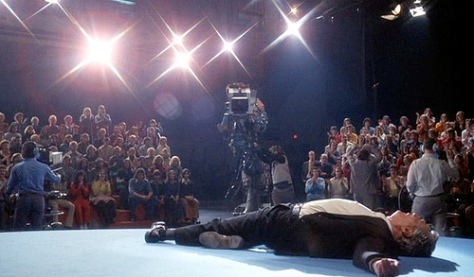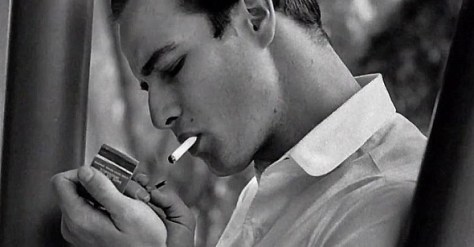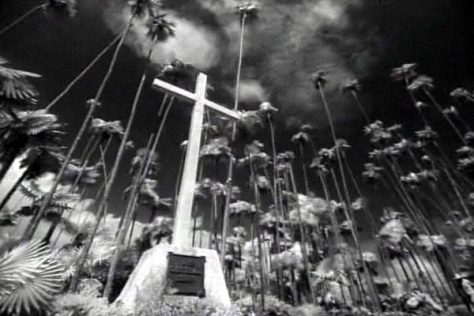By Dennis Hartley
(Originally posted on Digby’s Hullabaloo on August 29, 2015)

I love it. Suicides, assassinations, mad bombers, Mafia hitmen, automobile smash-ups: “The Death Hour”. A great Sunday night show for the whole family.
-from Network, screenplay by Paddy Chayefsky
There is an oft-repeated lament that Hollywood and/or television has “run out of original ideas”. Which is (mostly) true, but not necessarily indicative of a dearth of talent or creativity in the business. The blame for this particular writer’s block, I believe, can be laid fairly and squarely at the feet of…Reality.
Short of plundering Middle Earth or the comic book universe for ideas, it’s getting harder to dream up a scenario as “outlandish” as, say, having to undergo a security check before taking your seat at a movie theater, or as “unthinkable” as switching on the local TV news and witnessing the horror of what happened to the 2 WDBJ reporters and the interviewee while live on air last Wednesday.
You’re television incarnate, Diana. Indifferent to suffering, insensitive to joy. All of life is reduced to the common rubble of banality. War, murder, death are all the same to you as bottles of beer.
-from Network, screenplay by Paddy Chayefsky
While just as horrified and empathetic as anyone in their right mind should be when the WDBY story broke, I’m sad to report that I wasn’t necessarily surprised. It was only a matter of time. The on-camera assassination of two TV reporters filing an innocuous story about a mall seemed a relatively tiny jump from the random murders of two theater patrons in Lafayette earlier this month…who likely assumed they weren’t risking violent death by seeking out 2 hours of escapism at the matinee showing of a romantic comedy.
The common denominator of both incidents was all-too-familiar: An extremely disturbed individual with a legally purchased firearm, which they never should have been permitted to own in the first place. But who am I to judge, because, you know…Freedom. And Tyranny. And The Constitution.
Never mind that in early August, Amy Schumer (star of the film that the Lafayette victims went to see) and now this week, Andy Parker (father of slain TV reporter Alison Parker) have both made public vows to crusade for stricter gun control. As Mr. Parker was quoted, from an article in the August 27 New York Times:
“I’m for the Second Amendment,” he said on CNN Thursday morning, “but there has to be a way to force politicians who are cowards in the pockets of the N.R.A. to make sure crazy people can’t get guns.” Citing previous killings by people with mental illnesses, Mr. Parker asked, “How many Alisons will it take?”

What is uncommon about this latest tragedy, is that the alleged perpetrator himself was a former TV reporter, adding a chilling layer of irony to the already complex pathology in this case (note all the networks have taken pains to run that file clip of him reporting from a gun shop). This brings to mind a scene from Billy Wilder’s 1951 noir, Ace in the Hole:
Charles Tatum: What’s that big story to get me outta here? […] I’m stuck here, fans. Stuck for good. Unless you, Miss Deverich, instead of writing household hints about how to remove chili stains from blue jeans, get yourself involved in a trunk murder. How about it, Miss Deverich? I could do wonders with your dismembered body.
Miss Deverich: Oh, Mr. Tatum. Really!
Charles Tatum: Or you, Mr. Wendell-if you’d only toss that cigar out the window. Real far…all the way to Los Alamos. And BOOM! (He chuckles) Now there would be a story.
Tatum (played to the hilt by Kirk Douglas) is a cynical big city newspaper reporter who drifts into a small New Mexico burg after burning one too many bridges with his former employers at a New York City daily. Determined to weasel his way back to the top (by any means necessary, as it turns out), he bullies his way into a gig with a local rag, where he impatiently awaits The Big Story that will rocket him back to the metropolitan beat.
Of course, he’s being sarcastic when he exhorts his co-workers in the sleepy hick town newsroom to get out there and make some news for him to capitalize on. But the ultimate irony in Wilder’s screenplay (co-written by Lesser Samuels and Walter Newman) is that this becomes a self-fulfilling prophesy for Tatum; in his Machiavellian attempt to purloin and manipulate the scenario of a man trapped in a cave-in into a star-making “exclusive” for himself, it’s Tatum who becomes The Big Story.
Could it be that the Virginia shooter was using a similar kind of pretzel logic? Was he surmising that if he couldn’t achieve the notoriety he craved as someone who reports the news, perhaps he’d have better luck by simply grabbing a gun and creating some headlines himself? Was he really that hungry for attention?
The fact that his refrigerator door was papered with photos of himself could be a clue that at the very least, we are dealing with narcissistic personality disorder. It’s only a theory, but there’s a film that eerily presages that scenario, Gus Van Sant’s 1995 mockumentary, To Die For.

The film centers on an ambitious young woman (Nicole Kidman, in one of her best performances) who aspires to elevate herself from “weather girl” at a small market TV station in New England to star news anchor, posthaste. A calculating sociopath from the word go, she marries into a wealthy family, but decides to discard her husband (Matt Dillon) the nanosecond he asks her to consider putting her career on hold so they can start a family (discard…with extreme prejudice).
Buck Henry based his screenplay on Joyce Maynard’s true crime book about the Pamela Smart case (the most obvious difference being that Smart was a teacher and not an aspiring media star, although it could be argued that during the course of her highly publicized murder trial, she did in fact become one).
There is an even darker, macabre element about the Virginia shooter’s twisted act that, while it boggles the imagination, also has precedent in narrative films. Apparently not satisfied with orchestrating the murder of his victims to full effect in front of a live TV camera, he filmed his own POV version of what the viewers at home saw (it’s almost like he was directing a film, envisioning the different camera angles of the same event). It gets worse. He then proudly posted said video on his Facebook page for the world to see.

That was once only the stuff of horror movies, like Michael Powell’s 1960 thriller, Peeping Tom. The story profiles an insular, socially awkward member of a film crew (Carl Boehm) who works as a technician at a movie studio by day, and moonlights as a soft-core pin-up photographer. He’s also surreptitiously working on his own independent film, which goes hand-in-glove with another hobby: he’s a serial killer who gets his jollies capturing POV footage of his victim’s final agonizing moments.
It’s truly creepy; a Freudian nightmare. Powell, one-half of the revered British film making team known as The Archers (The Red Shoes, Black Narcissus, The Life and Death of Colonel Blimp) nearly destroyed his career with this one, which, due to its “shocking” nature, was largely shunned by audiences and critics at the time (thanks to Martin Scorsese, the film enjoyed a revival decades later and is now considered to be a genre classic on a par with Psycho).
Several subsequent films can be viewed as direct descendants of Peeping Tom; most notably Manhunter (1986), Henry: Portrait of a Serial Killer (1986), and perhaps more tangentially, Man Bites Dog (1992) and Natural Born Killers (1994).

Like the main character in Peeping Tom, the psycho killer in Michael Mann’s Manhunter (Tom Noonan) also has a day job that involves film; in this case he works in a film processing lab, which gives him access to the private home movies from which he chooses his victims.

John McNaughton’s Henry: Portrait of a Serial Killer follows the killing spree of the eponymous character (Michael Rooker) and his partner (Tom Towles). In a particularly chilling scene, McNaughton switches to shaky handheld POV shots of a video gleefully shot by Henry’s partner as they torture and murder their hapless victims.
I feel like I need a shower. If you want a 7th inning stretch…here’s a nice soothing image:

(Deep breath) Both Belgian directing trio Remy Belvaux, Andre Bonzel and Benoit Poelvoorde’s Man Bites Dog and Oliver Stone’s Natural Born Killers are sly send ups of the Spree Killer as Media Celebrity conflation. While I wouldn’t consider either film a “ha-ha funny” comedy, they both harbor a chewy nougat center of dark satire beneath a candy coating of Grand Guignol.

Man Bites Dog (arguably the most upsetting viewing experience of all the films discussed in this essay) takes the mockumentary approach, with a film crew “documenting” the murderous exploits of the protagonist (played by co-director/writer Poelvoorde). Initially, the film crew is objective, but cross the line into becoming criminal accessories.

Natural Born Killers, weirdly enough, actually features a “live on camera” killing of a journalist who has been tagging along with the murderous tag team (like Tatum in Ace in the Hole, he will use any means necessary to snag an “exclusive”).

There are several more satirical films of note containing over-the-top scenarios that reality has sadly caught up with, beginning with Woody Allen’s 1971 comedy Bananas. The specific scene that comes to mind in the wake of the Virginia incident involves Howard Cosell (playing himself) doing live TV coverage of a political assassination, as if it were a sporting event.
 Then there is Paul Bartel’s 1975 cult classic, Death Race 2000, depicting a dystopian America where public murder literally has become a popular televised sporting event, in which competing race drivers earn points for each luckless pedestrian they can run over and kill.
Then there is Paul Bartel’s 1975 cult classic, Death Race 2000, depicting a dystopian America where public murder literally has become a popular televised sporting event, in which competing race drivers earn points for each luckless pedestrian they can run over and kill.

The most recent film in this vein is from an artist who specializes in pushing people’s buttons, so be warned that many viewers will undoubtedly find stand-up comic-turned auteur Bob Goldthwait’s 2012 tragicomedy God Bless America incredibly offensive. His disenfranchised antihero Frank (Joel Murray) is like Ignatius J. Reilly, railing against all who offend his sense of taste and decency (but armed with an AK-47).
Already stewing over his ex-wife’s impending marriage, his little daughter’s detachment, his inconsiderate neighbors and his observation that most of his co-workers are obsessed with reality TV, Frank is pushed over the edge when he loses his job and is diagnosed with a brain tumor.
Frank’s first target is an obnoxious reality TV star, but his hit list expands to include wing nut pundits, Teabaggers, and the worst of the worst: people who yak on their cell phones in theaters and Yuppies who deliberately take up two parking spaces. On one level, it’s all quite appalling, but in light of recent events, it simply reflects our contemporary society.

This now brings us full circle to the most prescient film of them all, Sidney Lumet’s Network. In Lumet’s 1976 satire, written by the late great Paddy Chayefsky, respected news anchor Howard Beale has a complete mental meltdown on air, announcing his plan to commit public suicide, on camera, in an upcoming newscast.
When the following evening’s newscast attracts an unprecedented number of viewers, some of the more unscrupulous programmers and marketers at the network smell a potential cash cow, and decide to let Beale rant away in front of the cameras to his heart’s content, reinventing him as a “mad prophet of the airwaves” and giving him a nightly prime time slot.
Eventually, some of the truthiness in his nightly “news sermons” hits too close to home with network brass when he outs a pending business deal the network has made with shadowy Arab investors, and it is decided that his show needs to be cancelled (with extreme prejudice). Besides, his ratings are slipping. The network hires a team of hit men to assassinate him, “live” on the air.
Unfortunately, as has dogged me in previous such exercises, I come to the end of this study with no solid conclusion, no pat answers. Perhaps senseless is as senseless does. Some people are just bad machines. If we could just keep them away from the guns…that would be a good start. Otherwise, I’ve got nuthin’…except an urge to echo Andy Parker:
How many Alisons will it take?















 Then there is Paul Bartel’s 1975 cult classic, Death Race 2000, depicting a dystopian America where public murder literally has become a popular televised sporting event, in which competing race drivers earn points for each luckless pedestrian they can run over and kill.
Then there is Paul Bartel’s 1975 cult classic, Death Race 2000, depicting a dystopian America where public murder literally has become a popular televised sporting event, in which competing race drivers earn points for each luckless pedestrian they can run over and kill.















